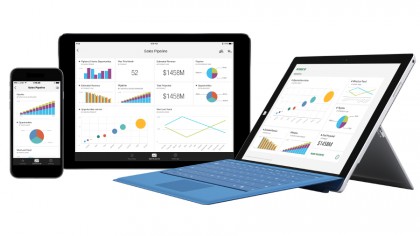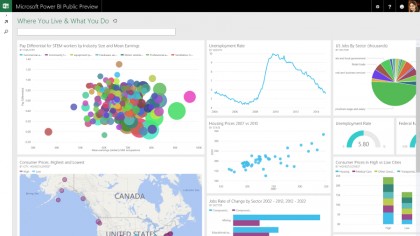Microsoft's new Power BI: a very different way of doing business intelligence
Business intelligence that works with all your data
You don't just get your cloud data, you get the data model – which means the natural language Q&A feature works straight away. He also points out that users don't need the technical expertise for Power BI that Watson demands.

This cloud connection puts Microsoft in a good position for today's web data and tomorrow's Internet of Things data. Databases and BI started in the transactional world of software designed to run your business, but "in the last decade and a half businesses have not just been using software the way they used to," Phillips points out.
"They have also used software in a different way to talk to customers. With websites and mobile applications, they're serving not just employees but customers measured in the millions or, if you're lucky, in the billions. That puts a pressure on transactional systems that is unprecedented and try as we have to tune it, twist it, turn it and harden it, you just need a different hammer."
Look forward and the problem just gets worse. "We've gone from systems of record to systems of engagement and there's another newer trend. Whatever business you're in, whatever you make is spewing data and it comes at very high velocity. That requires a different way of thinking about how I capture information because not only do I need to transact, I also need to respond to something happening in that stream."
That means a fundamental change in what you care about in BI, he believes. "Today BI almost always looks in the rear-view mirror. You get data, and then tomorrow you get it again. Now we're pivoting from historical only to real-time backed by historical."
Doing more cheaper
All that on-premise data still matters too, of course, and Phillips points out the "hundreds of thousands of data models on the planet that are in Microsoft SQL Server and Data Analysis Services." Power BI can automatically discover those – Phillips demonstrated that by finding a very long list of internal Microsoft databases – but you only get access if you have Active Directory permissions to use them. "You can connect it up to Power BI but you never have to move data to the cloud; it stays on-premise, locked inside your role level security model and you only get the data you're allowed."

He thinks Microsoft is unique in being able to handle both. "We cover the gamut on ways to build software systems and get value from data coming out of those systems."
Are you a pro? Subscribe to our newsletter
Sign up to the TechRadar Pro newsletter to get all the top news, opinion, features and guidance your business needs to succeed!
Phillips calls Power BI "the face of the Microsoft data strategy – it will be the tip of the spear for everything we do". In this new release, that means a free service you can sign up for with just an email address (as long as you're in the US – the international version follows soon). "No details, no credit cards, no CAL, no software," he promises – and much lower prices. "What we're selling today as the pro tier will be under $10 (around £6.50, AU$12.50) per user per month."
Mary (Twitter, Google+, website) started her career at Future Publishing, saw the AOL meltdown first hand the first time around when she ran the AOL UK computing channel, and she's been a freelance tech writer for over a decade. She's used every version of Windows and Office released, and every smartphone too, but she's still looking for the perfect tablet. Yes, she really does have USB earrings.